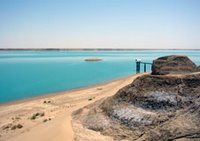
Tehran, 8 April 2006 (CHN) -- Archaeological excavations in Kenar Sandal in Jiroft led to the discovery of the second and most complete royal inscription in the raised platform, which once again proves the existence of a civilization in Jiroft during 3rd millennium BC.
“This linear brick inscription which is the most intact inscription discovered in this area so far is 11 centimeters in length, 7 centimeter in width and its thickness is 2 centimeters. This inscription has 5 lines and each line has almost 12 characters. According to a French expert in Elamite studies, this inscription must have been a king’s order. Considering the similarity of this inscription with another one which had been discovered during the previous season of excavation, most probably it is the second king order inscription discovered in Kenar Sandal so far,” said Nader Soleimani, archaeologist and a member of excavation team in Kenar Sandal to CHN.
This inscription was found in the discovered
ziggurat in the northern part of Kenar Sandal historical site. This
ziggurat is one to three centuries older than the most ancient
ziggurat in Mesopotamia.
Considering all these historical evidence, it is proved that Iran’s stone art was more developed than that of Mesopotamia. The art used on these stones shows Iranian skills in stone art during the ancient times. Such a delicacy can not be seen in Sumerian civilization of Mesopotamia during this period. Archaeological studies on the coals gathered during excavations in Jiroft revealed that the surface layer of this historical site dates back to 2800 BC. Besides, the geophysical studies of French experts in this historical site show the existence of 11 architectural layers beneath this
ziggurat.Archaeologists believe that Kenar Sandal enjoys a history of more than 6000 years, and the discovered
evidence indicates the settlements of human beings in a region as vast as the Sumerian civilization in Mesopotamia. All of these together with the discovered inscriptions have somehow convinced archaeologists that Jiroft’s civilization is more ancient than that of Mesopotamia which is believed to be the most ancient civilization of the world.
The
first inscription discovered in Jiroft studied by five linguists from the United States, France, Russia, Denmark, and Iran revealed that this Elamite script was 300 years older than that of the great civilization of Susa. Based on these new findings, archaeologist believe that Jiroft was the origin of Elamit written language in which the writing system developed for the first time and was then spread across the country and reached Susa. Now the second discovered inscription will be decoded by linguists from the United States and France to prove this claim.
The city of Jiroft is situated close to Halil Rud historical site. Halil Rud, located on the basin of Halil Rud River, was one of the first places where civilization and urbanization were established. Up until now, many stone and clay objects as well as other historical evidence belonging to the third millennium BC have been discovered on the 400-kilometer basin of Halil Rud River during the archeological excavations and also the illegal diggings by the smugglers. Archaeological excavations are still continuing in north and south shores of the Halil Rud River in order to discover different dwellings, architectural evidence, and cemeteries.
One of the most important architectural structures discovered in this area is a
ziggurat belonging to the first half of the third millennium BC. Iranian and foreign archaeologists are searching to discover the original architectural form of this
ziggurat.
A ziggurat is a temple tower of the ancient Assyrians and Babylonians, having the form of a terraced pyramid of successively receding stories. One of the best remained ziggurats is
Tchogha Zanbil situated southwest of Iran in Khuzestan province.
Archeologists strongly believe that the new discoveries in Jiroft historical site may change the trend of the civilization of the world.


















